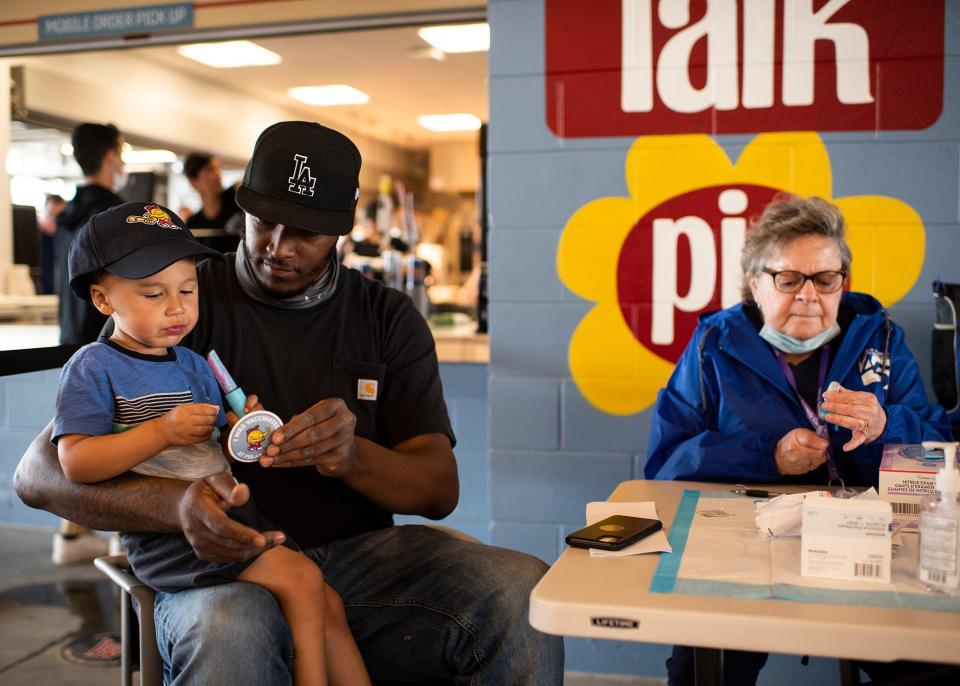More fathers are working from home and becoming the main caregiver to their children
Michael Holder, 33, worked at an accounting firm in Florida for five years until the coronavirus pandemic exploded. His colleagues didn’t seem to care about wearing a mask, even though 10 of them shared a small office space in which they could hardly keep social distance. Holder was anxious and worried all the time, and the stress led him to quit his job in October 2020.
After that, his wife went from being a stay-at-home mother to going back to work as a nurse. It was Holder’s turn to stay at home taking care of the house and his two young children - a four-year-old boy and a one-and-a-half-year-old girl.
An identity crisis soon kicked in.
“I had been an accountant for five years, and then suddenly I was not, I was a full-time parent. From October and for about five months, I went through a very, very hard time. I was not sure if staying with the kids was what I wanted to do full time. I was very depressed, anxious, and angry,” said Holder.
For over a year, the pandemic has forced parents to do full-time childcare and house chores alongside their regular jobs. While most of this extra workload has fallen on women, an unprecedented number of men are spending more time at home than ever before, sometimes taking on full-time childcare because they lost their jobs or earned less than their partners. Some said they have been left with feelings of shame, isolation or depression, treated as anomalies or failures, while others are relishing spending time with their children.
Related video: Why working from home might be here to stay
“It's still not seen as widely normal in most of the world,” said Gary Barker, president of Promundo, an international nonprofit focusing on positive masculinity. “It’s partly because men who are doing the stay-at-home care-work feel like they're freaks, like they're strange.”
The pandemic claimed 22.4 million jobs and while most Americans have since returned to work, the mass unemployment crisis, combined with the closures of schools and child care centers across the nation, forced many fathers to take on the burden of childcare at home, Barker said.
Although women were disproportionately hurt by the economic shutdown, with nearly 2 million losing their jobs between February 2020 and April 2021, men were affected too. Nearly 1.6 million men left the labor force in the same period, according to the National Women’s Law Center.
Barker expects after the pandemic more men will choose to embrace the primary caretaker role even when presented with other options because their families appreciate it and staying home for part or the entire workday will have become normal for them.
"Full-time stay-at-home dads will likely continue to be a minority but we will see more men spending more time as part-time caregivers while also being full-time/part-time workers,” Barker said.
But for many men taught they must provide, it can be uncomfortable to find yourself at home without a paycheck.

Holder said he found himself in a constant bad mood after he became a stay-at-home father, occasionally losing his temper with his wife and children. He felt pressured by his inability to conform to traditional gender roles that for decades saw men work outside of the house to provide financial support for the household and women focus on the care work at home.
“My parents were pretty supportive; they didn't judge me for deciding to leave my job. But, although they never said so, I am assuming my in-laws, who hold more traditional values and think the man should provide for the family while the wife stays home with the kids, are probably a bit disappointed in me that I am not taking care of their daughter the way they might want me to,” said Holder.
‘We still hold on to this gender role’
Stay-at-home fathers have for years tried to break gender stereotypes and move away from traditional ideas of masculinity.
Fathers made up 17% of all stay-at-home parents in the United States in 2016, according to the Pew Research Center. That’s up from 10% in 1989.
Fathers are increasingly more involved with their children’s lives even when they aren’t working full-time at home. In 2016, fathers reported spending an average of eight hours a week on child care, about three times more than in 1965. They also dedicated about 10 hours a week to household chores, compared to four hours in 1965.
Meanwhile, in 2016, mothers spent an average of 14 hours a week on child care and 18 hours a week on housework.
Paid family leave policies that exclude men have often made it difficult for fathers to take on more work at home, especially in low-income families where two incomes are needed to survive. President Joe Biden has called for a nationally mandated 12 weeks of paid family leave and his administration has vowed to invest more in the care economy, meaning the work and caring for children and other relatives, which is worth $1.5 trillion but mostly involves unpaid work and falls on women.
Paying parents to take care of their children would be a step in that direction, allowing more men to take on primary childcare duties, said Daniel Singley, a San Diego-based board-certified psychologist and director of The Center for Men's Excellence, which focuses on men’s health.
“It's a game changer,” Singley said. “More parental leave would reflect that society sees the importance of early parenthood as an inflection point, for the health of the parents, for the health of the baby, and sees the need to allocate resources and give them the time to settle into their parental roles and to be there for their baby.”
Companies also need to create a culture when men are encouraged to put their families first, Singley said.
“Culturally, most dads don't take (paternity leave) because of shame, a sense that they're going to be looked down upon,” Singley said.
Outside of the workplace, fathers could use more support throughout society, Barker said.
“Fathers go into playgroups and they are most likely surrounded by women. They may feel strange, and start questioning ‘who am I if I'm not a provider?’ Paid work is how we define our identities. My real worth as a man is still very much measured in terms of ‘am I actually bringing home a paycheck,’” said Barker.
Like Holder, many men describe going through a rough time when they become stay-at-home fathers. And some said society's judgments are real, and not just self-doubting voices in their heads.
“Even though times are changing, there's still a strange idea that a man who stays at home while the woman works is somehow being taken care of - as if he were a child. We still hold on to this gender role,” said Eric Marsh, a father who co-founded The Fathering Circle, a peer-support organization for men. “A woman that stays home is doing a woman's role or a mother's role.”
Marsh, who lives in Philadelphia, with his five children and now ex-wife, said he struggled after he lost his work in 2009.
“I was at home and my wife, who was pregnant, was still going out to work. It was a very awkward feeling. I felt it internally for myself: there's something wrong here. Why are you not working? There is this pressure on men to be the breadwinner and to be the main source of income. We need to let go of this outdated way of thinking,” said Marsh.
‘I am not angry anymore’
Support groups for fathers, such as the National At-Home Dad Network, The DADvocacy Consulting Group or City Dads, have mushroomed in recent years across the United States to help men navigate their new roles.
Holder said attending virtual meetings through the At-Home Dad Network gave him a chance to connect with other stay-at-home fathers worldwide.
“I ended up starting personal therapy as well, just to deal with my anxiety and depression and anger. It was a complete 180-turn. I'm not angry anymore,” he said.
Mark Greene, creator of Remaking Manhood, an online community dedicated to expanding the conversation about healthy masculinity, has for the majority of the past 12 years worked at home as the primary caretaker for his child while his now ex-wife has been the breadwinner.
“I began to understand that no matter who's doing that work, at some point, that work starts to become a little invisible. And it's that invisibility of the work which is exhausting,” he said.

Greene said he found it isolating to not be able to connect with other adults outside his home, the way many coworkers do with their coworkers.
“There are many issues associated with the traditional masculine performance, the lack of emotional intimacy, the inability to connect with people that are different than us,” said Greene.
Greene is also a member of the Mankind Project, a men’s support group. He said some men wait too long before seeking out help.
“Those guys show up sometimes, but they only show up after everything is falling apart, their marriages failed, they've lost their jobs, their health is going down. And suddenly this whole dominance pyramid is not something they can count on anymore. So those guys will change but only after it all falls apart for them,” Greene said.

Being ‘a real man’
To be sure, many men are enjoying their time with their sons and daughters.
A Harvard University study published in June 2020 found almost 70% of fathers across race, class, educational attainment and political affiliation in the United States felt closer to their children during the pandemic.
“We hear a lot of men coming out of COVID saying, ‘I'm not going back to the office full time because I want to be in my children's lives, I don't want to go back to this thing where I never see my family.’ So this hybrid understanding of our work lives versus this deeply enriching relationship with our children, that's emerging out of COVID as well,” Greene said.
The pandemic could help more men see the value in caring for loved ones and their homes, Greene said.
“I believe COVID will accelerate the process by which lots of people say, I don't want there to be this arbitrary division between my work life and my family life. I don't want my work life to say, if you're a real man, if you're a real attorney, if you're a real doctor, if you're real whatever, you don't see your family because that means you're not committed to the work,” Greene said.
Holder is approaching his one-year anniversary of being a stay-at-home dad. He said it has made his marriage stronger.
“It took some time and communication to understand one another. It also took me apologizing and saying, ‘I’m sorry, I took you for granted,’” Holder said. “Now we’ve completely switched roles. At the moment, I do all the housework, and my wife doesn’t do much at all. But we've come to that understanding, and she appreciates it. This whole experience was eye-opening because you think you know everything that needs to be done as a stay-at-home parent, but until you're doing it yourself, you don't quite get the full picture,” said Holder.
Follow Ignacio Pereyra on Twitter at @pereyranacho.
This article originally appeared on USA TODAY: Stay-at-home dads on the rise with COVID-19 as more work from home

 Yahoo Movies
Yahoo Movies 

